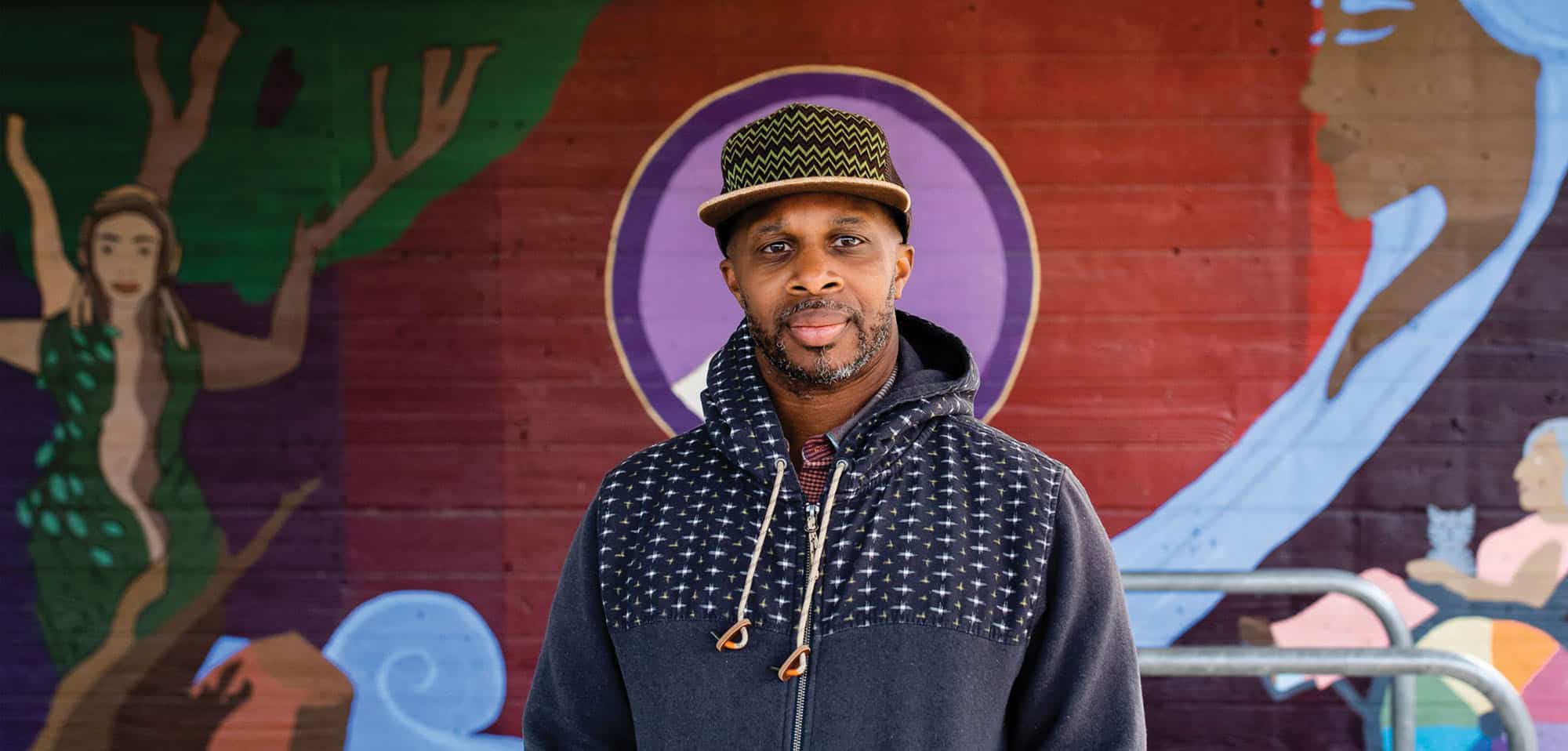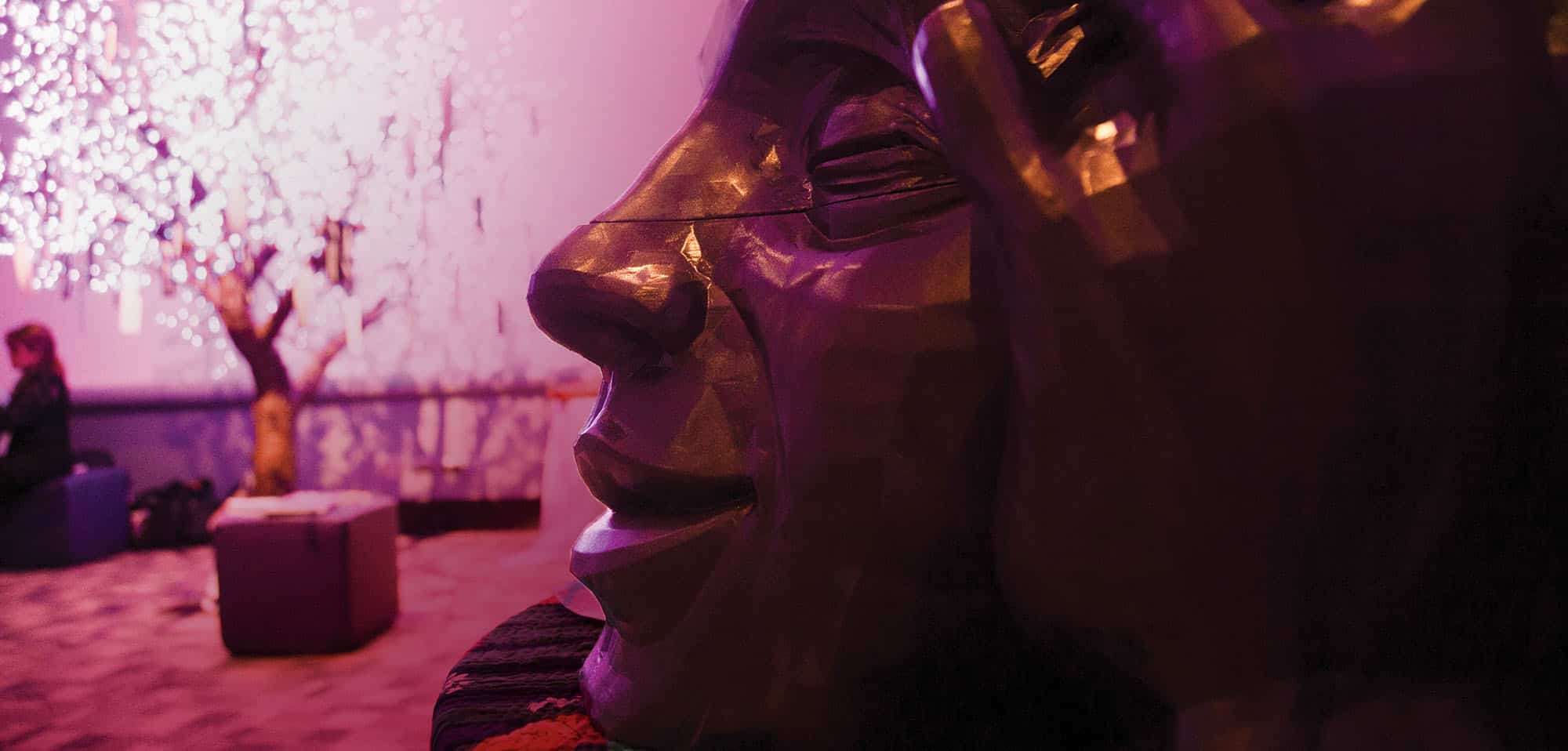The bang on the door and bellowing Time’s up! signal we have five minutes to put our clothes on before PAC’s double doors yank open by Dale, a large burly man, who works security at Naropa, smoking cigars and guarding the doors on the nights we dance naked in PAC.
It is the mid-1990s and dancing naked at Naropa—and in Boulder—is a thing. It’s what many of us who have been socialized female are doing en masse via word-of-mouth invitations at clandestine locations, like Naropa’s Performing Art Center (PAC), mostly at night. I am new to Naropa—a transplant from central New York, who came to Colorado for Naropa— and I don’t yet grok the favorable news of “no ground” and won’t until years later. Only now, reflecting on my 30 years at Naropa, do I understand the wisdom of Chögyam Trungpa Rinpoche’ s words: The bad news is you’re falling through the air, nothing to hang on to, no parachute. The good news is there’s no ground.
In the 1990s, I prefer ground, including dancing naked on PAC’s hardwood floor because unlike the sloping rocky terrain of the Foothills, where we also dance naked, PAC’s floor appears to be solid—a concept disproved by quantum physics, but still. In PAC, I can twirl without worry of tripping over a boulder and twisting my ankle. I can slither on my belly with ease through the Hide-N-Side. Its plastic mesh play tubes have been placed in a row in the center of the floor and covered in multiple shades of fleshy-colored scarfs to simulate a birth canal for us to slide through to rebirth ourselves. This is fitting, given that Naropa’s seal, displayed above PAC’s double doors, has the Sanskrit words prajña-garbha written in Tibetan script at its base that translate as “womb of wisdom.”
There is no ground and no parachute (in the womb). Still, I feel parachuted into Naropa’s underground (i.e., counterculture) by some higher consciousness that is shaking up my very foundation, most especially my relationship with sex. For the first time in my life, sex becomes personal, with an emphasis on being rather than doing that mind-blowingly is not focused on pleasing another. I have landed in a place that is inviting me to become embodied, requiring synchronization of body and mind, which (for me) translates to being sex rather than doing it.
I am invited to turn toward myself sexually, examining all the ways this part of my life has existed in the shadows, especially with regard to my personal pleasure. The invitation presents itself on my first Halloween at Naropa, when I run <<smack>> into a person with a penis with a bag over their head and nothing else in the parking lot behind the Naropa Café on the Arapahoe campus, as I mindlessly hurry out of my car toward the building, late for work. The bag has slits for eyes, nose, and mouth, and muffles an apology. “Sorry!” the bag says, as it grabs me to keep me from falling. It is an unnecessary apology given that I ran into “him.” I am speechless and say nothing back.
This is emblematic of Naropa and its mishap lineage—attracting and/or inviting the unruly counterintuitive willingness to fail as a form of resistance, which is what queer theorist Jack Halberstam (2011) refers to as the queer art of failure.
Later, I am struck by the ordinariness of the encounter— one person running into another, both startled, in a parking lot on a sunny fall day. The fact that one of us is naked and the other is clothed makes it an extra-ordinary encounter, akin to ordinary magic—a hallmark of contemplative education—a stripped-away psychological and emotional nakedness that encounters the ordinary in an extraordinary and spontaneous way. Notably, this encounter is feet away from where I will first meet the Dalai Lama, when he is at Naropa for an interfaith dialogue, walking and talking casually. I am struck by this “unlikely pairing” of distinct yet interrelated embodied expressions of nakedness in Naropa’s parking lot.
In 2016, I write about “The Erotic Academy” in the Naropa Magazine, explaining:
In a sex-phobic culture, it is risky to consider higher education erotic. Yet at its best, that is what I believe contemplative education is, or at least should be: Erotic—searingly so, as it stimulates an aroused between space—a tension that teeter-totters a body between knowing and not-knowing, between comfort and edge (Clements, p. 38).
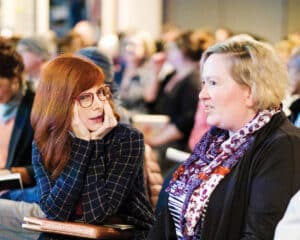
Thirty years after my arrival at Naropa, I remain sandwiched between comfort and edge, and work to stay here with students as we establish an erotic relationship with academic content and one another, neither of which is explicitly sexual. Eroticism is related to gender, sex, and sexuality, but not synonymous with them. For Audre Lorde (1984/2007), the Black female lesbian social-activist poet, eroticism is the life force of women, and the vehicle by which Black women can reclaim their power. Naropa, in my experience, offers pathways to reclamation. Eroticism is one of the vehicles.
My first erotic encounter at Naropa—a month into my arrival—is on reproductive justice. I attend a small leaderless group for those who have had abortions, having read the flyer on the bulletin board in the hallway advertising it minutes before, and spontaneously walk in. Talking about one’s personal experience of abortion is an edge state—then, and now. I enter the small conference room in Naropa’s makeshift Sycamore annex—currently adjacent to the Pamela Krasney Pavilion—where people are squeezing around a rectangular conference table, filling every chair. Several participants have had more than one abortion, a “shameful” admission that many admittedly find relieving to share aloud. The meeting is electric, with crying, clapping, cheering, anger, and laughter. It is a synergistic take-back—an erotic reclamation of the power that has been stripped from the marginalized bodies of those who are most directly affected by the sociocultural stigma of abortion, those who typically identify as female. I write this 30 years later, after Roe v. Wade has been overturned, and where quite recently, on November 7, 2023, Ohioans voted to enshrine the right to abortion in their state constitution amid a flurry of draconian legislative measures throughout the United States to deny access to abortion to people with uteruses who need and/or want it.
I arrive at Naropa at 30, and remain at 60, precisely because I had an abortion. In my first group process at Naropa, I learn that I am not alone. Pain and “failure” lead people here. Due to the failure of the sponge’s barrier method, which is 80–88% effective rather than full-proof, I find myself unexpectedly pregnant and at the proverbial Fork in the Road. Taken off the market in 1994, the year I arrive at Naropa, due to bacterial water and air contamination at the plant that produced it, the sponge’s failure leads to my flourishing. This is emblematic of Naropa and its mishap lineage—attracting and/or inviting the unruly counterintuitive willingness to fail as a form of resistance, which is what queer theorist Jack Halberstam (2011) refers to as the queer art of failure. Unsurprisingly, it is a concept that resonates with queer and non-queer Naropa students alike.
The sponge fails me, then I choose to “fail” (i.e., have an abortion) while praying in St. John’s Catholic Church in Utica, New York. By all accounts, a Catholic church is a queer place to seek abortion advice, that for me proves prophetic, when I hear an internal voice whisper: It’s okay (which at the time I interpret to be Jesus’s). Soon thereafter, I receive an admissions packet from Naropa that I had requested months prior, containing a course catalogue and complimentary VHS (i.e., Video Home System) analog cassette tape, featuring Bataan and Jane Faigao demonstrating t’ai chi ch’uan (the contemplative martial art that I will later study with them), and Barbara Dilley (who will become my first meditation instructor) dancing.
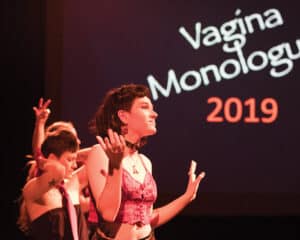
Naropa’s seal features prominently on the catalogue’s cover, and immediately I am struck by its likeness to the image I drew during a guided visualization in therapy in Poland, New York (before I ever heard of Naropa) when my therapist suggests that I imagine a “sacred and safe” place. I envision Root Glen, on Hamilton College Campus in Clinton, New York, near my childhood home. In my mind’s eye a “Native American” man suddenly appears with a “steering wheel on fire” above his head. He is encouraging me: Look at the ground beneath your feet, it will lead you to where you need to go. Turns out that the man is Tibetan, not Native American, and Naropa’s founder, Chögyam Trungpa. The steering wheel above his head is Naropa’s womb of wisdom. I take his advice—letting the ground beneath me lead me, like the prophet Fred Flintstone—and drive westward toward Colorado with my friend, John—heating my grandmother’s cabbage and potatoes and cheese perogies (i.e., Polish dumplings) on the dashboard with the defrost on high.
As in-our-faces as doing it is, we are often confused by and unhappy with sex in a culture that is more comfortable talking about sexual trauma than sexual pleasure. We are frequently ashamed of our sexuality, worried, for example, that we don’t “measure up” to normal, most especially in our desire for or frequency of Doing Sex. Sadly, there are precious few models of Being Sex, even for me, a sexuality scholar, sex educator, and sex and relationship therapist. Yet despite (or because of) its controversial history with sex, Naropa may prove to be one such model, because it invites us to teeter-totter at the edge of uncertainty and wonder. This is a dynamic state that I refer to elsewhere as weebling (Clements, 2016, p. 38), referencing Hasbro’s egg-shaped roly-poly toy from the 1970s, with the advertisement slogan: Weebles wobble but they don’t fall down. In other words, amid an aroused (emotional, psychological, and physiological) state, we learn to balance ourselves between comfort and edge—erotically (and mindfully)—to become nimble and curious about how to make sense of sex within historical context and (if partnered) within relational complexity.
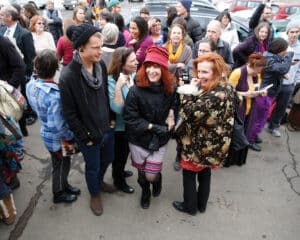
I liken weebling to a form of embodiment that lies dormant until we summon it, as I did when I was asked to write this article about sexuality at Naropa for its 50th anniversary. Hanging on the wall in our refinished basement (fittingly underground) is the watercolor that Ericka—my first roommate in Boulder, an undergraduate art therapy student at Naropa at the time— painted of me dancing naked in PAC weebling, with arms stretched high above my head, a billowing scarf in my hands, as I twirl to the rhythms of the drumbeat in PAC, naked in public for the first time.
Things change in 30 years, privately and publicly, perhaps more so in 50. In 1973, the year before Naropa is founded, the Supreme Court legalizes access to abortion nationwide in Roe v. Wade. In 2022, it rescinds the federally protected right in Dobbs v. Jackson Women’s Health Organization. Sexual expression and freedom of the 1960s and 1970s is replaced with sexual uncertainty and fear in the 1980s with the AIDS crisis and political fear-mongering. There is also much to say about sexuality at Naropa through the years, as it relates to both contemplative education and the larger sociopolitical context, making sex a function of beingness not just doing.
Some things also stay the same. In the recent present, while serving as dean of undergraduate education, standing in front of the Lincoln building talking with President Lief, a naked skateboarder rides passed us—with a guitar strategically hung. In the Halloweens since my first encounter with the penis in the parking lot, I have dressed as a “Prophylactic Princess” handing out candy and condoms to interested Naropian Trick-or-Treaters.
Contemplative education is both trick and treat. So is sexuality, and needs to be further unpacked— in context and in its complexity, especially at Naropa. Being Sex divorces sex from the white cisgender heteronormative way of doing it, allowing for diverse sexual desires and expression, as with Ginsberg’s poem “Sphincter.” Being Sex is liberatory, counterculture, counterintuitive, and confusing. It invites us to fall through the air with no parachute and no ground—not a smooth nor easy ride. If we are not careful, this counterculture approach can burn us, like happened to Ericka and me when sunbathing topless on a break from classes on the banks of the Boulder Creek, when the cops arrive and tell us to put our shirts on. We had fallen asleep. The underexposed tender parts of us—our nipples, to be exact—got badly burned. A reminder that falling asleep amid moments of beingness (sexually and otherwise) can have negative repercussions to bodies and minds.
References
Clements, C. (2016). The erotic academy: How mindfulness misses the mark. Naropa Magazine.
Halberstam, J. (2010). The queer art of failure. Duke University Press.
Lorde, A. (2007). In Sister outsider. Ten Speed Press. (Original work published in 1984)

